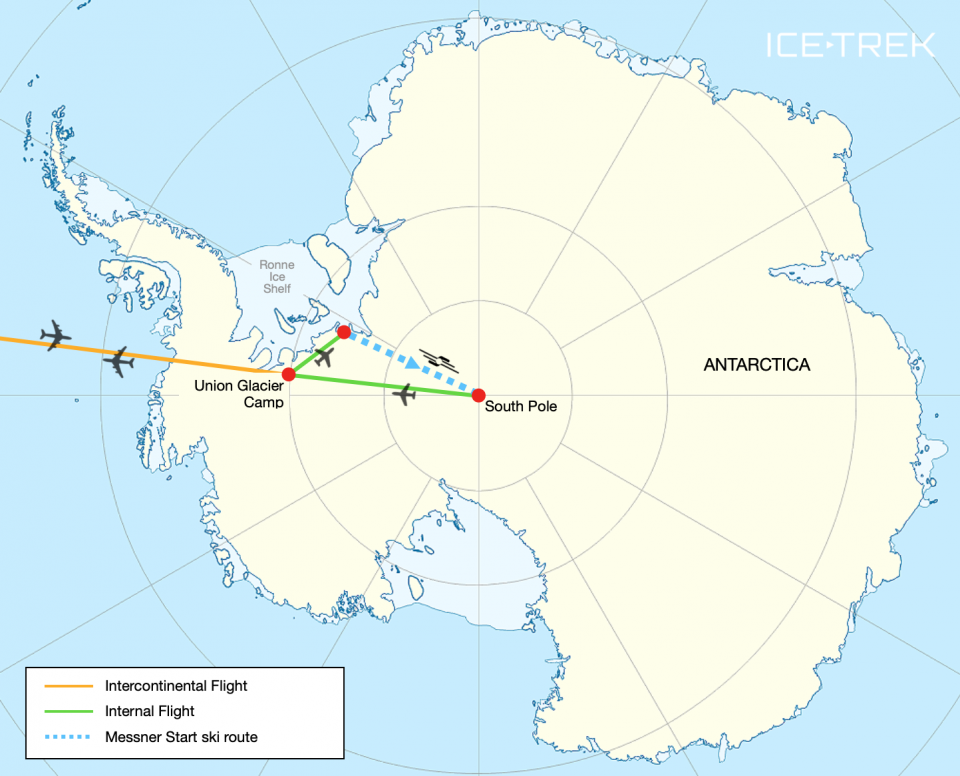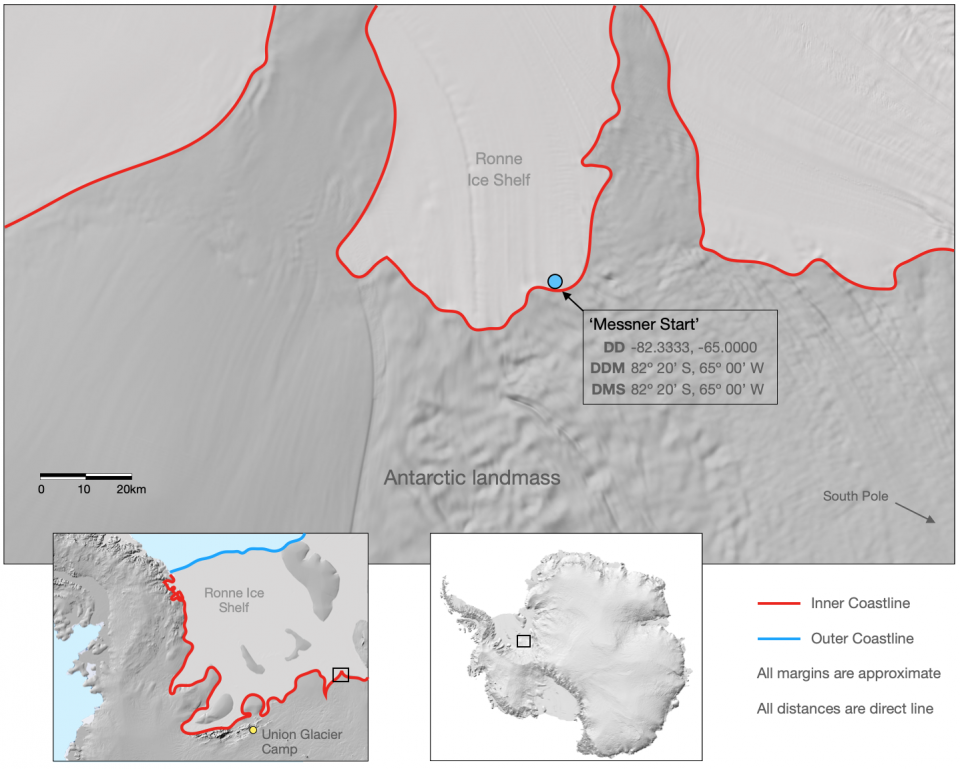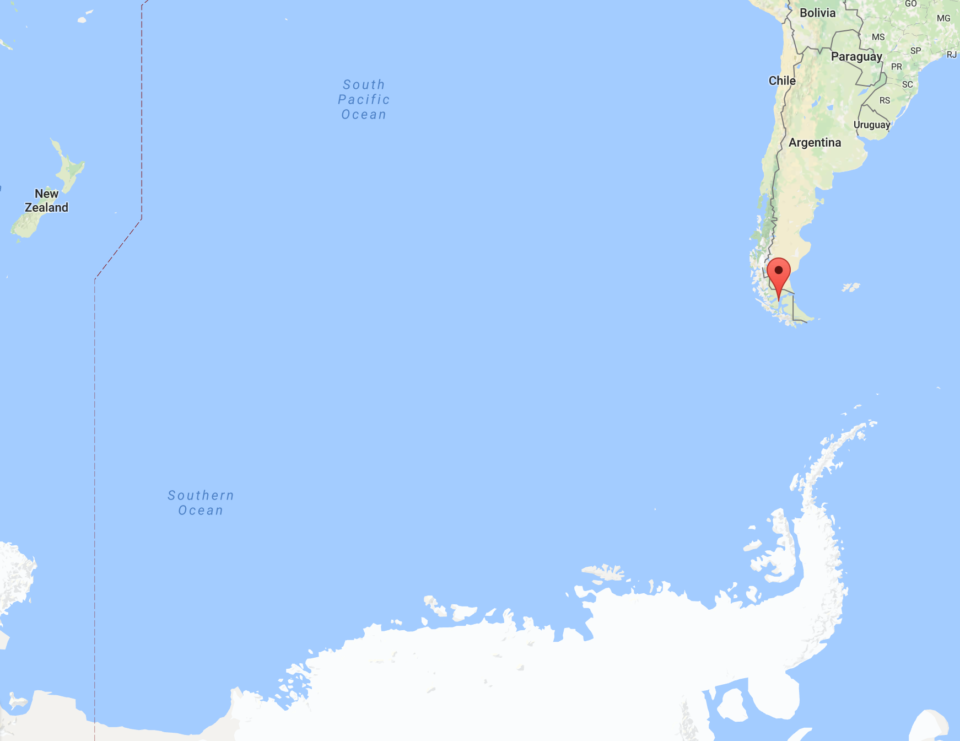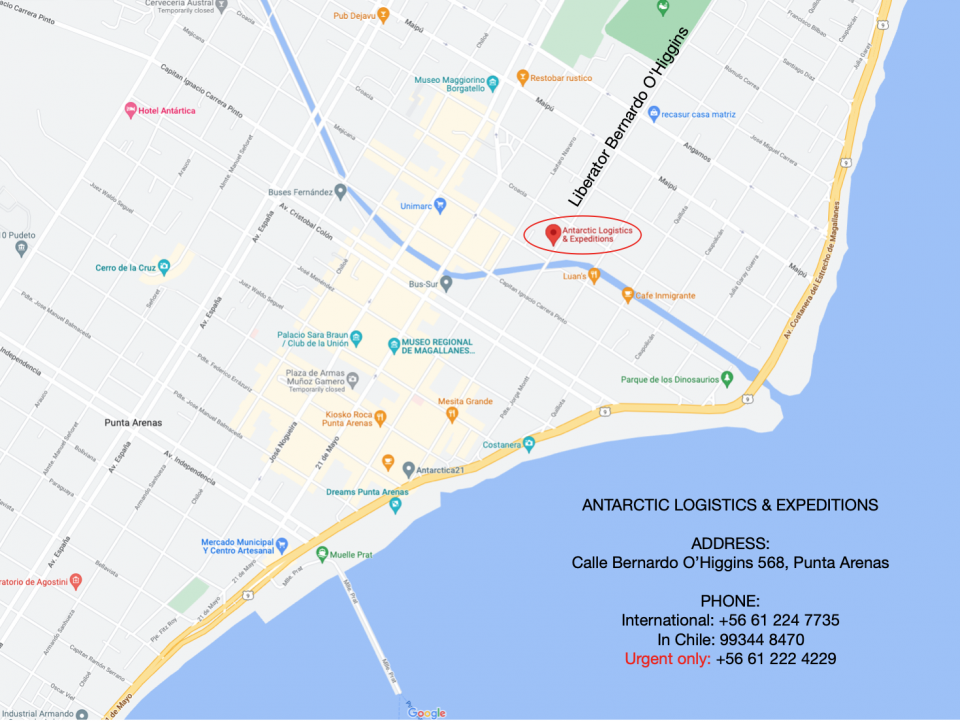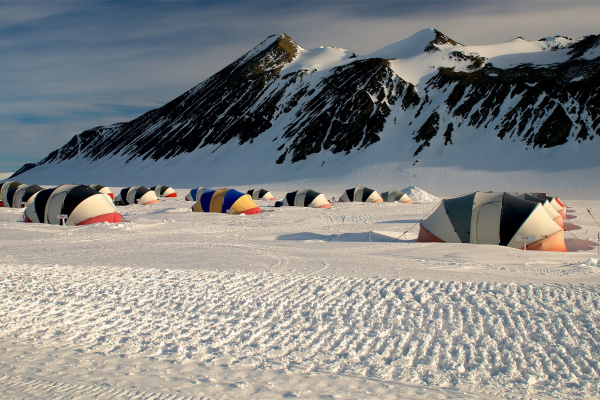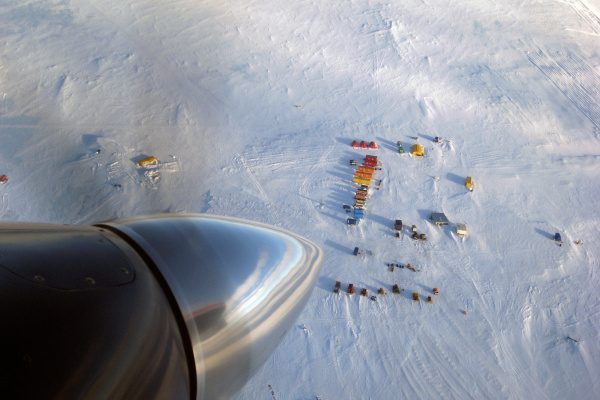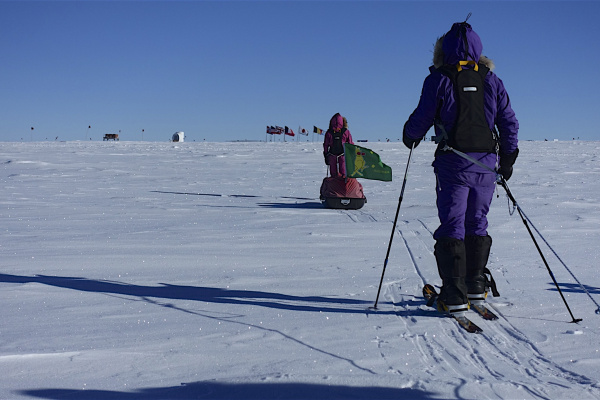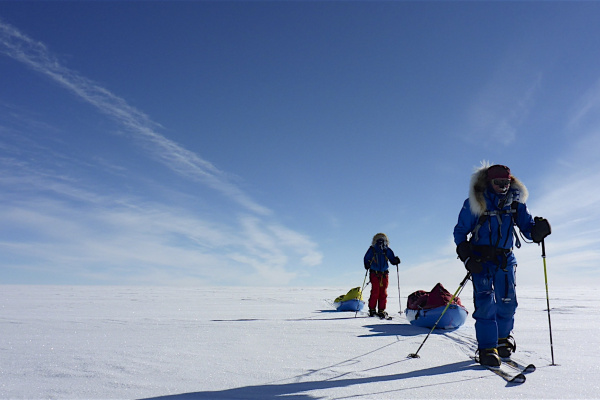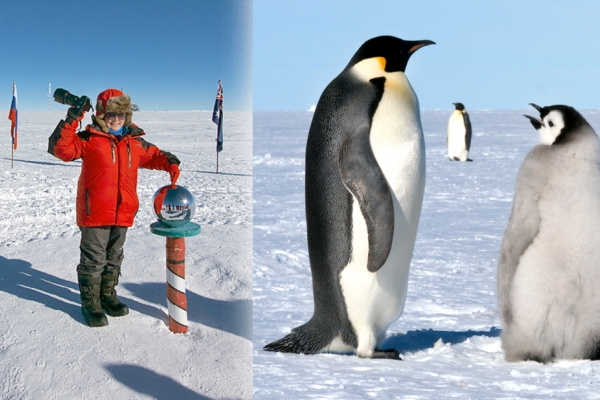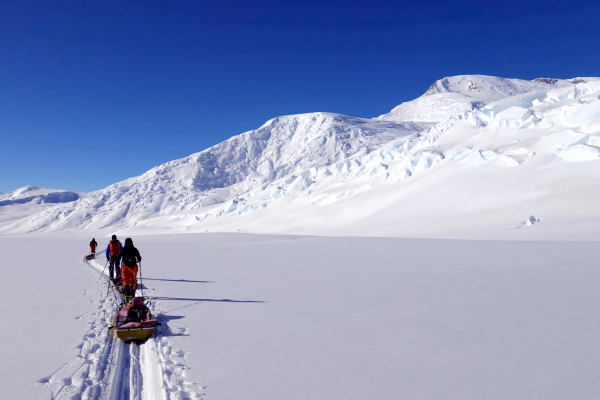Ski from Ronne Ice Shelf to South Pole
The Messner Start, named after the famed mountaineer Reinhold Messner, extends 911km from the Ronne Ice Shelf to the South Pole. Test your limits on this demanding Antarctic expedition.
- Gateway Punta Arenas, Chile
- Distance 911km
- Days on Ice 54
- Daily Distance 20+km
- Temp. Range -10 to -35°C
- Sled Weight 60-80kg
- Challenge 6 What's this?
- Conditions Altitude, wind, cold
- Challenges Daily distance, cold management, altitude, sastrugi, crevasses
Trip Itinerary
Arrive Punta Arenas. Check-in to hotel
Luggage pick-up, briefing and Covid testing
Fly to Union Glacier Camp in Antarctica
Expedition preparations
Ski Ronne Ice Shelf to Thiel Corner Skiway
Ski Thiel Corner Skiway across the plateau to the South Pole
Arrive at the South Pole
Flight to Union Glacier
Flight to Punta Arenas, Chile
Fly home
Subject to change based on weather and flight conditions.
Inclusions
- Airport transfers in Punta Arenas, Chile
- Round trip flight to Antarctica from Punta Arenas
- Flight to Messner Start from Union Glacier
- Flight to Union Glacier from South Pole
- Meals and tented accommodation in Antarctica
- Camping equipment, sled, and harness
- Expedition Guide
- Celebration dinner and Certificate of Achievement
- Checked luggage up to 66 lb (30 kg)
- 20% discount on selected Icetrek Equipment
Exclusions
- Insurance coverage—personal, medical, evacuation, or otherwise
- Commercial flights to and from Punta Arenas
- Airport transfers outside of Punta Arenas
- Meals and accommodation in Punta Arenas
- Additional flights within Antarctica
- Personal equipment and clothing
- Expenses incurred due to delays
- Luggage over 66 lb (30 kg)
- Satellite phone charges
After final preparations at Union Glacier Camp in Antarctica we fly by Twin Otter aircraft to our Messner Start point on the edge of the Antarctic continent.
From Messner Start on the inner edge of the Ronne Ice Shelf we ascend south towards the Thiel Mountains and South Pole.
With 70-80kg sleds we slowly make our way up the Foundation Ice Stream and onto the Antarctic plateau covering 20-25 km's daily. After a few days we find our rhythm and become a part of Antarctica, skiing, resting, eating and sleeping to a routine that has been time honoured by over a century of explorers. We aim for the Thiel cache where we pick up a resupply of food and fuel before heading onto the high plateau.
The Antarctic plateau is a forbidding place - cold, windswept and remote, with rarefied air. This of course is part of the attraction of skiing to the South Pole, to experience one of the most exacting environments on earth. By now we are a well-oiled team, we have developed specific skills to match the challenge and our professional equipment serves us well. We rely implicitly on all that surround us.
This 911km expedition should only be considered by the most committed adventurers, willing to undertake a rigorous daily training schedule for several months prior to their trip. Messner Route to South Pole is a serious undertaking requiring supreme skill, fitness, mental strength and teamwork.
Morning
We wake around 6am and a call goes out to all of the tents. The temperature inside the tent is usually pleasant, if the sun is shining sometimes it can be hot! We camp in pairs so while one lights the stove the other has the luxury of snoozing a little longer. But eventually everyone is sitting up in their comfortable camp seats, enjoying the warmth and sipping on a hot tea or coffee.
A hearty breakfast of high-energy porridge with milk powder, desiccated coconut, crushed pecans and protein powder, together with butter for those needing the energy, gets us fired up and ready for the day of hauling. We call it our breakfast bomb. But we have it as late as possible so that all of its energy is available for the morning sessions. Reheating thermoses and melting snow for water is also a morning task, one that consumes a fair bit of time.
Slowly we start to pack all of our belongings, timing everything with the completion of snow melting so that once all tasks are done we can exit the tent and start packing our sleds. Hopefully we have choreographed this with the other tents so that no-one is waiting in the cold.
First session
Around 8.30am, tents collapsed, decamped and sleds packed, we clip into our harnesses, check our bearing and begin the first session of hauling. A few days into the trip and we will have found a daily routine and rhythm that suits the team, something like 4 sessions of 2 hours each with 20-minutes break in between, a little longer for lunch. Sled hauling is not very difficult when conditions are perfect, pulks often glide easily across the ice. It gets tougher when we are confronted by sastrugi and softer snow as we get closer to the pole.
Your guide is highly experienced in all situations - crevassing, extreme cold and team management are all part of his/her quiver of skills.
Break
If it's cold we'll put on our down jackets during the breaks, over the top of the harness. A day bag containing food and drink, and anything else you might need during the day, is kept in the nose of the sled for easy access and it's not long before we're sitting on our sleds downing a selection of delicious snacks including crackers, energy bars, dried fruit and nuts, lollies and chocolate which help to keep us going during the next session. The breaks also serve as toilet stops.
Second session
After 10 minutes we are off again, heading south across the vast ice cap. There's opportunity for you to be out front, breaking trail, route finding, navigating, decision making. Don't worry, your guide is always nearby and ready to give advice or take over.
Your skis, skins, bindings, ski poles and boots are all designed for this kind of expedition. It takes a little while to become accustomed to the bulkier ski equipment, but eventually it feels very natural and it is certainly very warm. Your clothing too is designed to keep you warm and comfortable in the coldest of temperatures.
The weather can be anything from blue skies, no wind and -35c to warm, sticky blizzards where the temperature can rise to -10c. Snow, clouds, almost anything is possible up here but the closer we get to the South Pole the more likely we will have stable weather with blue skies.
Lunch
We stop for lunch sitting in the shelter of our sleds and put on warm jackets and take our skis off. First task is to add hot water to our noodles so that they are ready to eat in around 3 minutes. A chunk of cheese in with the noodles provides a mouth-watering stringy melt that is both soft and delicious. The lunch break is a great opportunity to chat, or just enjoy the surroundings, whatever you like.
Afternoon sessions
We also carry goggles and a change of hat in our day bag. Blue skies and calm can switch to blizzard, or anything in between, so we need to have quick access to variations in our head and hand wear so that we stay warm and dry. The art of polar travel includes reducing perspiration to a minimum and we do this through venting - allowing the moisture to escape. Base layers wick moisture away from the skin, fleece layers continue the transfer while keeping us warm and breathable shell layers allow the moisture to escape to the outside. Zippers strategically located on our shell-wear assist in the venting process and a skilled traveler knows the importance of actively managing the moisture within. So no matter the weather, we remain in fine control of our body temperature and dampness through a balance of food, fluids and clothing.
As the day progresses we feel the onset of fatigue. And no wonder - we have travelled up to 8 hours, crossed sastrugi fields, scanned for crevasses, covering a distance of between 20 and 25km . It's time to camp.
Evening
After selecting a camp site we pitch tents. Snow is shovelled on the tent valances for added security and sealing from blizzards and a bag of snow blocks for melting is collected. After tossing anything we need for the night inside we climb in and prepare a cosy and ordered interior. Soon the stove is purring, snow is melting and damp things hang on the drying line. Soup, dinner and some squares of chocolate for desert await and banter fills the tent. For those staying in touch, satellite phones and modems are warmed and the world hears of our progress through phone calls, emails, texts and blogs. We can send images too, bringing our wonderful expedition to life for the folks back home. A daily call to Union Glacier camp keeps their expedition manager up to date and we get a weather report, which we can also download on our modem. You also have the opportunity for a digital detox, staying free from the outside world and being happy to leave your smartphone in Punta Arenas.
On average, our day is divided into three eight-hour periods. The most important one is sleep - eight hours is available if you want it. Eight hours of hauling also becomes a standard as it helps us to cover ground and pace our day. The third eight hours is anything not sleeping and not hauling - rests, lunch, chores and camp life. If we need to cover more distance during the day we can easily compress our down time to give more hauling time, but sleep is sacrosanct, critical for our health and happiness. And after all is done we turn the stove off, slide into our sleeping bags, ruffle our down jacket pillow and sleep the sleep of explorers, to awake to a new dawn and live a day in Antarctica once again.
Latam Airlines fly daily to Punta Arenas, Chile.
.
Prior to departure there will be a briefing held at Antarctic Logistics and Expeditions. Their office is located at:
Calle Bernardo O’Higgins 568, PH: +56 9 6832 7472
WHAT IS A MESSNER START TO SOUTH POLE SKI EXPEDITION?
Messner Start to South Pole is a ski and sled hauling expedition from the inner coastline of the Ronne Ice Shelf to 90º south, the Geographical South Pole. The distance is 492 international nautical miles, 911km kilometres and 566 statute miles.
Can I leave bags in Punta Arenas?
Yes. Your bags will be collected and delivered to your past-Antarctica hotel on the day of your return.
*
What should I wear on the flight from Punta to Union Glacier?
You will be briefed in Punta on exactly what to wear and bring on the flight to Union Glacier Camp. Usual airline restrictions apply.
*
How long is the flight to Union Glacier?
The flight from Punta to Union Glacier takes around 5 hours.
*
Should I take money and my passport to Antarctica?
Union Glacier Camp sells souvenirs in USD. You are required to bring your passport as you will board an international flight to Antarctica.
*
What will be the temperature on arrival at Union Glacier?
Depending on when you arrive the temperature at Union Glacier will be anywhere from -5 to -25ºC, 23 to -13ºF
*
How heavy will my sled be?
For a South Pole last degree expedition your sled will be 60 to 80 kg, 132 to 176 lb.
*
What if I am not a skier?
It’s preferable you come with some cross-country ski experience but some of our South Pole Last Degree customers have spent little time on skis. We will coach you while you are on the ice, it’s not a highly technical skill when anchored to a sled.
*
How long is the flight to Messner Start?
It’s around a 2 hour flight from Union Glacier to Hercules Inlet.
*
Will there be any crevasses?
Yes, there are crevasse fields to negotiate but they are very well marked on our maps and in our GPS devices.
*
Will there be any sastrugi?
Yes, sastrugi (wind-formed ridges of hardened snow) are a normal part of a ski expedition. The largest sastrugi are encountered between 86 and 88º south.
*
What type of sleds do we use?
We use large expedition-style sleds with flexible traces (hauling lines).
*
What type of tents do we use?
We use Hilleberg Keron 4-person tents for two people. There is plenty of room to get comfortable but small enough to warm up quickly once the stove is operating. You are responsible for setting up, managing and taking down your tent.
*
Who cooks the meals and melts the snow for water?
You do! This is a normal part of expedition life. We train you how to use the stove.
*
What if there is an emergency and how will we communicate with the outside world?
We carry Iridium handheld phones and are in daily contact with Union Glacier Camp.
*
How long do we ski every day on a South Pole expedition?
We start relatively gently, skiing for around five hours on the first day. We cover this by skiing one hour, then have a short stand-up break, then another hour with a sit down break. We do the same again and have lunch and then another 2 hourly sessions before camping. When everybody feels ready we extend to 7 and perhaps eight hours per day.
*
How do we know when we are at the South Pole?
The Amundsen-Scott South Pole Station is positioned on the South Pole. Depending on conditions we will likely see it the day before we arrive.
*
Feel free to submit your own questions.
